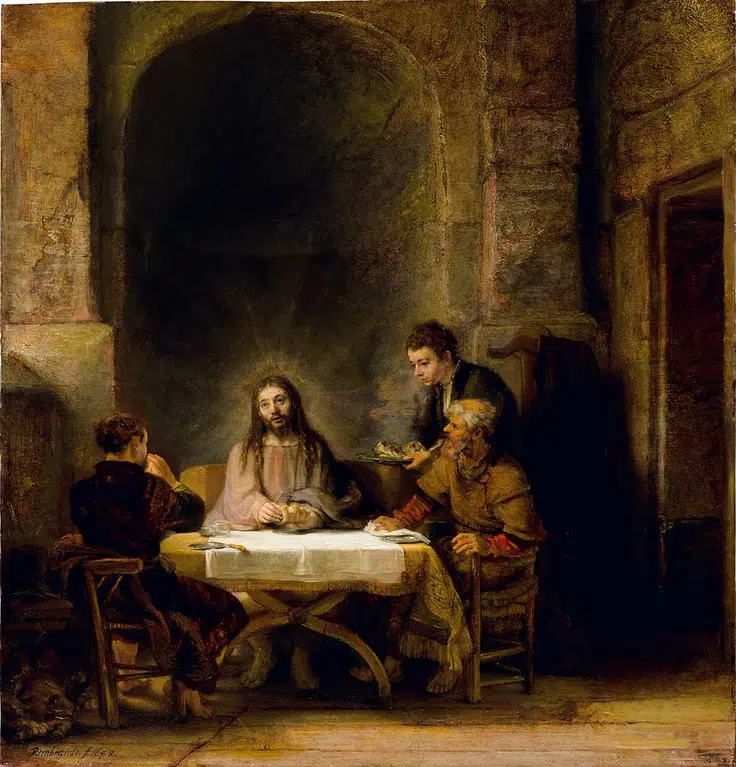It is worth the trip and the price of admission for “Rembrandt and the Face of Jesus,” on view at the Philadelphia Museum of Art until Oct. 30, just to see the Dutch artist’s “Supper at Emmaus” of 1648, newly cleaned and on loan from the Louvre in Paris. This famous oil painting is surrounded by the largest number of Rembrandt’s finest paintings, etchings and drawings depicting Jesus Christ and the events of His life that has ever been assembled in one place.
The story of Emmaus told in Luke 24 was Rembrandt’s favorite Bible theme. On Easter day, two of Jesus’ followers were going to the village of Emmaus, despondent over the Crucifixion. Jesus walked with them, explaining through Scripture, beginning with Moses and continuing through the prophets, that the Messiah was intended “to suffer all these things and then to enter his glory.” As Luke recounts, “They saw him, but somehow did not recognize him.”
When the pilgrims stopped for supper, “He sat down to eat with them, took the bread and said the blessing: then he broke the bread and gave it to them. Then their eyes were opened and they recognized him, but he disappeared from their sight.”
Rembrandt’s 1648 picture depicts the moment when Jesus breaks the braided challah loaf and His followers open their eyes.
“It’s a sacramental picture,” said exhibition curator Lloyd DeWit. He pointed to Leonardo da Vinci’s “Last Supper” as a source of inspiration. In a drawing also in the exhibition, Rembrandt had copied a print of the “Last Supper” but, DeWitt noted, heightened the eucharistic solemnity of the original by drawing a canopy behind Jesus.
In the “Emmaus” painting, natural light beams in from the upper left, while divine light haloes the face of the Savior, sets aglow the praying hands of a disciple with his back turned to the viewer, and picks up glints of scarlet and gold in the clothing of the seated figures in the dark room.
Rembrandt’s two light sources may relate metaphorically to the two candles lit during Mass, symbolizing the two ways in which Christ is present to us in the “one table of God’s word and Christ’s body,” just as Jesus in the Emmaus story first fed his followers with the word and then with the host.
The quiet drama of an invisible transformation is heightened by the fact that the upper half of the painting is empty of figures. Behind Christ is a huge arch carved from rough stone intended to evoke, according to DeWitt, an early Christian basilica. This suggestion of a church apse turns the table into an altar.
Rembrandt and his followers portrayed the Emmaus story over and over. In the Philadelphia exhibit there are two more paintings by pupils, several drawings of the journey to Emmaus and the supper, an etching of 1654 by Rembrandt, and a bookplate recording his last painted “Supper at Emmaus,” now lost, in which Jesus has vanished and the pilgrims gaze at only light. A mysterious panel in the Metropolitan Museum in New York gains a new reading – as the risen Christ, garbed as a pilgrim, embarking on the road to Emmaus.
Unity of faith
The face of Jesus in the “Emmaus” painting – mild, vulnerable and inward – is different from the impassive Christ of European tradition before Rembrandt (for comparison, the Philadelphia museum has many such portrayals in their permanent collection). Cardinal Justin Rigali, former archbishop of Philadelphia and an honored guest at the exhibition opening, said that by making Jesus humble and empathetic, Rembrandt has shown us “what is divine in the human being.”
Rembrandt’s revolutionary vision in the “Emmaus” painting was based on a series of small oil paintings of the head of Christ on wood, which have been gathered for this exhibition, studied from life and apparently using a young man from Amsterdam’s Jewish community as a model. Defying centuries of anti-Semitism in Europe, Rembrandt portrayed Jesus as a Jew.
Rembrandt’s later religious paintings often allude to Christ’s renewal of Mosaic law, suggesting that he was exposed to the ideas of a group of Christian theologians called Philosemites, who sought reconciliation between Christians and Jews. They were hundreds of years ahead of their time.
It should be added that without Catholicism, there would have been no pictures of Jesus. Although his first teacher (and quite a few of his patrons) belonged to Amsterdam’s large Catholic minority, Rembrandt was a Protestant, and the Dutch Reformed Church was the established religion of the Dutch Republic. Strict Reformed theology banned all images of Christ as idolatry. Catholic theologians, on the other hand, argued that since Christ is the word made flesh, images of Him are lawful and indeed, necessary.
No painter before Rembrandt had ever made this so palpably real.
Hamerman, who teaches art and catechesis at Christendom Graduate School in Alexandria, can be reached at [email protected].



